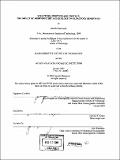Structure, function and context : the impact of morphometry and ecology on olfactory sensitivity
Author(s)
Hammock, Jennifer, 1974-
DownloadFull printable version (22.20Mb)
Alternative title
Impact of morphometry and ecology on olfactory sensitivity
Other Contributors
Woods Hole Oceanographic Institution.
Advisor
Darlene R. Ketten.
Terms of use
Metadata
Show full item recordAbstract
In this thesis, the relationships of olfactory sensitivity to three biological variables were tested. The sensitivity of a marine mammal, the sea otter (Enhydra lutris) was measured in order to determine whether a marine lifestyle results in impaired olfaction. The effect of dietary relevance on sensitivity to specific odorants was evaluated. Finally, a new morphometric model of olfactory uptake efficiency was developed and tested against behavioral measurements of olfactory sensitivity in twelve mammalian species from five orders. Olfactory thresholds were obtained for the first time from two sea otters for seven odorant compounds from various natural sources. Otters were trained using operant conditioning to participate in direct behavioral testing. Sea otter olfactory sensitivity was comparable to that of previously studied terrestrial mammals. The incidence of an odorant in the diet of the olfactor was found to influence specific sensitivity to that compound but to varying degrees among different mammalian orders. Nasal cavity specimens were measured using radiologic (CT scan) and histologic (light microscopy) techniques. Surface areas and volumes of the nasal cavity were used to calculate the Olfactory Uptake Efficiency (OUE). OUE is significantly related to olfactory bulb volume. A possible relationship was found between OUE and general olfactory sensitivity.
Description
Thesis (Ph. D.)--Joint Program in Oceanography/Applied Ocean Science and Engineering (Massachusetts Institute of Technology, Dept. of Biology; and, the Woods Hole Oceanographic Institution), 2005. Handwritten on CDROMS: v. [1]. Appendix, histological images -- v. [2]. CT images. -- Table of contents refers to CDROMS as: Appendix and CT and histological images for all species, attached CD) Includes bibliographical references (v. 2, leaves 216-247).
Date issued
2005Department
Joint Program in Oceanography/Applied Ocean Science and Engineering; Woods Hole Oceanographic Institution; Massachusetts Institute of Technology. Department of BiologyPublisher
Massachusetts Institute of Technology
Keywords
Joint Program in Oceanography/Applied Ocean Science and Engineering., Biology., Woods Hole Oceanographic Institution.